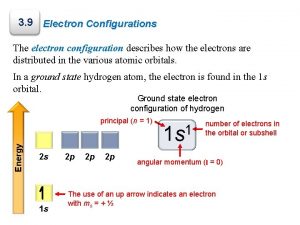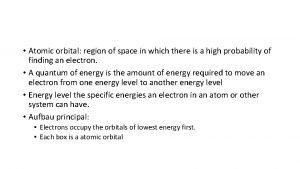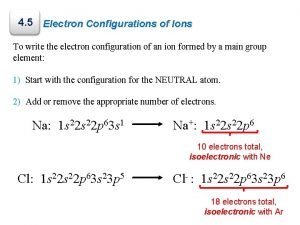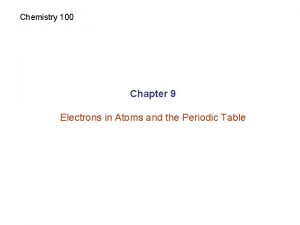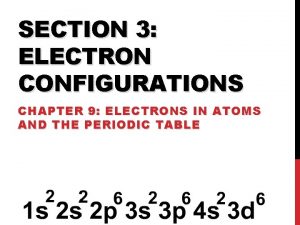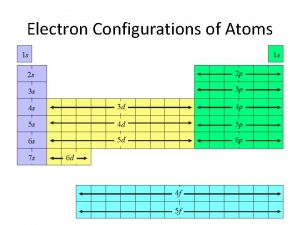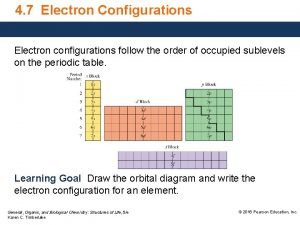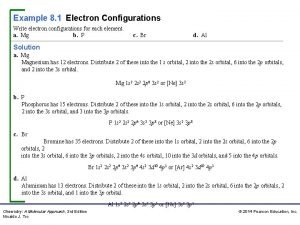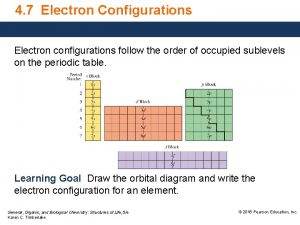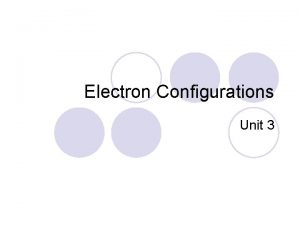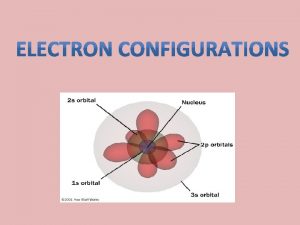ELECTRON CONFIGURATIONS CHEMISTRY 332 WHAT IS AN ELECTRON



















- Slides: 19

ELECTRON CONFIGURATIONS CHEMISTRY 332

WHAT IS AN ELECTRON CONFIGURATION(EC)? • Describes the location of the electrons in an atom • Described by shell, subshell(sublevel), and orbital • If you were to go to a Cubs game, you would have to buy a ticket. The ticket would tell you specifically where you should sit.

SHELL & SUBSHELLS • Shell • energy level (aka principal quantum number), represented by n • coefficient in an EC • Subshells(Sublevel) energy level • identified by s, p, d, or f in an EC • number of sublevels per shell is equal to the shell number Example 2 p 2 energy sublevel

SHELL & SUBSHELLS

ORBITALS • Orbitals • region where there is the highest probability of finding an electron • each orbital has a different shape • s = sphere • p = peanut • each sublevel also has specific number of orbitals • s = 1 orbital; p = 3 orbitals; d = 5 orbitals; f = 7 orbitals • superscript describes how many electrons are in each orbital

S ORBITALS

P ORBITALS

D ORBITALS

HOW DO THE ORBITALS CHANGE AT DIFFERENT ENERGY LEVELS? • Orbital increase in size with increasing energy level.

BASIC ELECTRON CONFIGURATION PRINCIPLES • Pauli Exclusion Principle • each orbital contains a maximum of two electrons • Aufbau Principle • electrons occupy orbitals of the lowest energy first • Hund’s Rule • every orbital is singly occupied with one electron before any one orbital is doubly occupied

ELECTRON CONFIGURATIONS & THE PERIODIC TABLE • How does the periodic table relate to electron configurations? • Each row represents the shell or energy level. • For example: The first energy level has how many electrons? • n = 1; 1 subshell = s; 1 s-orbital • 2 electrons per orbital gives 2 electrons in the first energy level! • The first row on the periodic table has two elements!!!

CONTINUED • Still not convinced! Let’s look at another example: • The second energy level has how many electrons? • n = 2 ; 2 subshells = s & p; 1 s-orbital & 3 p-orbitals • 2 electrons per orbital gives 8 electrons!!! Whoa!!! That was tough!!!! • The second row on the periodic table has 8 elements!!!!

ELECTRON CONFIGURATION PERIODIC TABLE • Lets write this information on our periodic table, write the energy level on the left hand side of your periodic table. 1 2 3 4 5 6 7

ELECTRON CONFIGURATION PERIODIC TABLE • We can also draw in sublevel locations. Please color coat the sublevels on your periodic table.

PERIODIC TABLE PROBLEM • If we look at n=3, there are only 8 elements in the row but there are suppose to be 18 electrons in the energy level. (You should be able to figure out the number of electrons!!) • As you increase the energy level the electrons tend to overlap in complicated ways. • The “d” subshell is actually one less than the row it is in.

7 s 6 s Energy 5 s 4 s 6 d 6 p 5 p 3 d 3 p 2 p 1 s 4 d 4 p 3 s 2 s 5 d 5 f 4 f


EXAMPLE • Write the full electron configuration for nitrogen(N) • 1 s 22 p 3 • The orbital diagram shows where each electron is located. Each electron must be opposite to the other electron in each orbital. • Draw the orbital diagram • ____ 1 s ____ 2 s ____ 2 p 3 s ____ 3 p

VALENCE ELECTRONS • Electrons in the highest energy level; only in the and p sublevels • Nitrogen Example: • 1 s 22 p 3 • What is the highest energy level? • Which electrons are the valence electrons? s
 How to write the electronic configuration
How to write the electronic configuration Stable electron configurations are likely to contain
Stable electron configurations are likely to contain 1s 22 s22 p63 s2
1s 22 s22 p63 s2 Electron configuration for ions
Electron configuration for ions Stable electron configurations are likely to contain
Stable electron configurations are likely to contain Stable electron configurations
Stable electron configurations Chapter 5 electrons in atoms
Chapter 5 electrons in atoms Ceedar innovation configurations
Ceedar innovation configurations Design chart for flexible pavement
Design chart for flexible pavement Electrons configurations
Electrons configurations Ac load line analysis of transistor
Ac load line analysis of transistor Electrons configurations
Electrons configurations Electronic configurations
Electronic configurations Bipolar transistor configurations
Bipolar transistor configurations Electrons in atoms section 3 electron configuration
Electrons in atoms section 3 electron configuration Cse332
Cse332 14:332:331
14:332:331 Digital vs analog sound
Digital vs analog sound Syair carolina
Syair carolina 14:332:331
14:332:331
